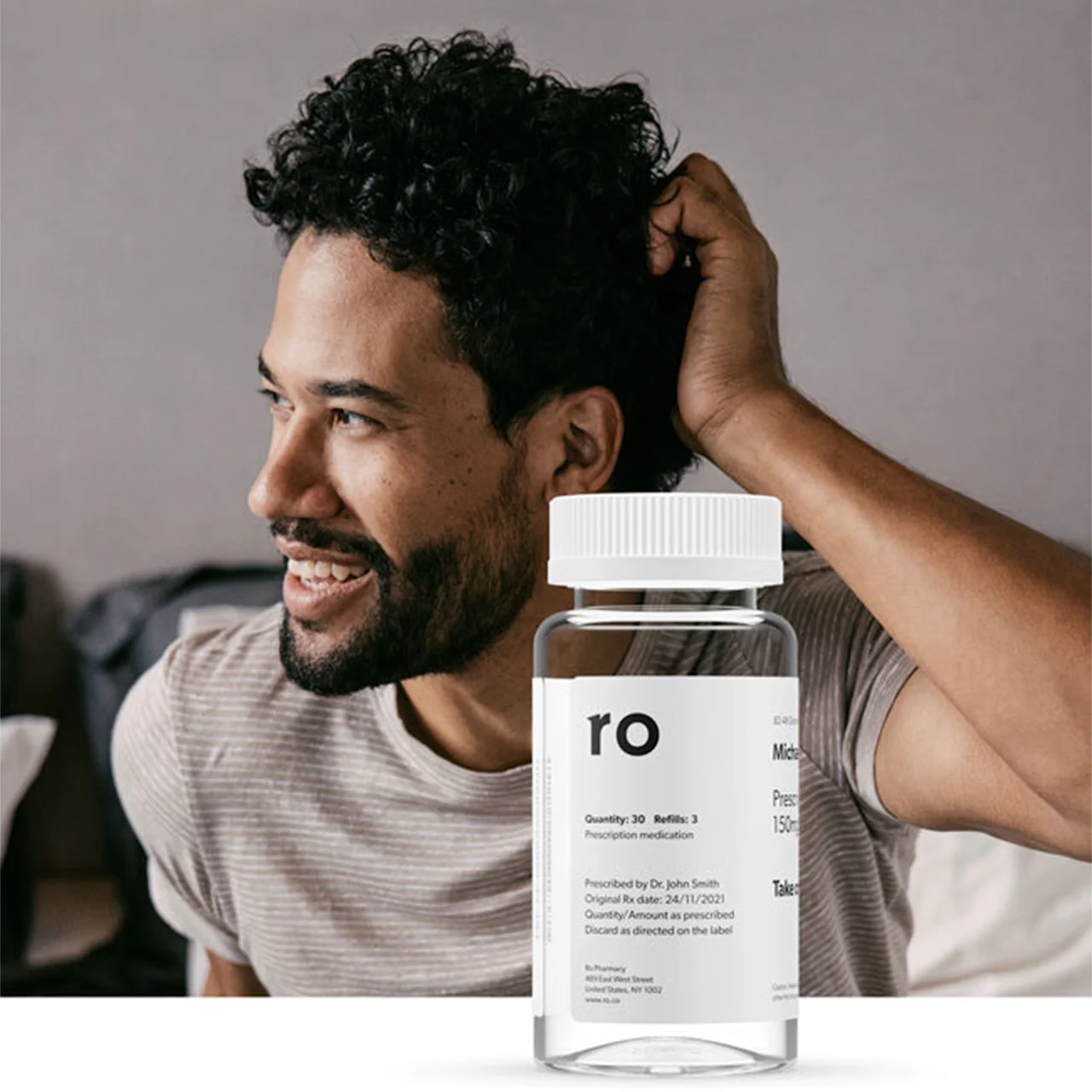Here's what we'll cover
Here's what we'll cover
Here's what we'll cover
As some men age, they may notice their once thick head of hair becoming thinner and thinner. This is often due to a condition called androgenetic alopecia, which affects around 50% of men in the United States by age 50 (Ho, 2021).
More commonly known as male pattern hair loss or male pattern baldness, androgenetic alopecia is a predictable pattern of hair loss. Hair usually first thins around the temples, leading to a receding hairline. Hair loss may progress to involve the vertex of the scalp, also known as the crown of the head. As the hair continues to thin, it may lead to complete baldness (Ho, 2021; Suchonwanit, 2019).
The experience of thinning hair isn’t only relegated to those who identify as men, though hair loss in others may be slightly different. In those assigned female at birth, hair usually thins all over the head, and the hairline doesn’t typically recede. However, the hair part may become wider and wider (Ho, 2021).
Why does hair loss happen, and what can be done about it? Read on to learn more about improving hair growth, decreasing hair loss, and how minoxidil effectively works on the hairline.
What causes a thinning hairline?
Why does the hairline thin, anyway? The answer begins with how hair growth occurs and the role hormones play in hair growth and hair loss.
Hair growth starts in your hair follicles, located deep in the skin. Hair strands remain in the growth phase (anagen) for 2 to 6 years before entering their rest phase (telogen). The hair strand falls out a few months after the rest phase starts. This triggers the follicle to begin the growth process over again, growing a new strand of hair for the next few years, a cycle that repeats itself hundreds of times (Murphrey, 2021).

This is where hormones come into play—specifically, a group of hormones called androgens. Androgens are typically considered “male” hormones, but all people have them. Researchers believe dihydrotestosterone (DHT) is the specific androgen affecting hair loss (Ho, 2021).
For reasons not well understood, people with androgenetic alopecia make more DHT and develop extra androgen receptors in the hair follicles of the balding areas. This allows extra androgens to affect the growth process, leading to thinner hairs and a shortened growth cycle (Ho, 2021).
Does Rogaine work for a receding hairline?
The short answer is yes. Rogaine can help a receding hairline—but only if it's used as recommended. It’s important to keep in mind that it can take at least 3–4 months of regular use to see results (Suchonwanit, 2019).
Rogaine is the brand name for the topical medication minoxidil. It comes in either a liquid solution or topical foam. It is available over the counter in two strengths—2% or 5%. Although both are effective, clinical trials show the 5% dose has better results than the 2% dose. Rogaine is typically used once or twice daily. It must be used daily for the best results (Suchonwanit, 2019).
When used topically, very little medication is absorbed into the body, so the side effects aren’t typically severe. The most common side effects include irritation and itching on the scalp.
How does minoxidil work?
Initially introduced in the 1970s, minoxidil started as a pill used to treat severe high blood pressure. When people who were balding took minoxidil, they noticed they were starting to grow hair. Upon this discovery, the medication was reformulated into a topical formula specifically for hair regrowth (Suchonwanit, 2019).
Researchers still don’t completely understand why the topical minoxidil solution causes hair to regrow. Minoxidil works as a vasodilator, meaning it helps open up small blood vessels and improves blood flow. This is thought to help the hair growth cycle (Suchonwanit, 2019).
When applied to the scalp, the topical solution is absorbed into the skin, where it works in the hair follicle. Researchers believe minoxidil increases how long the follicle is in an active growth phase. This can improve the receding hairline by decreasing hair loss while promoting hair regrowth (Suchonwanit, 2019).
Best treatment for receding hairline
Frontal hair loss isn’t fixed through old wive’s tale remedies or by wishing it away. However, there are multiple options for hair loss treatment. Supplements, oral prescription medications (finasteride), topical treatments, and even hair transplants are all options. For a receding hairline, the sooner it’s acted on, the better. Studies show that treatment with minoxidil can improve a receding hairline (Suchonwanit, 2019).
When searching for the best treatment for hair loss from androgenic alopecia, have a discussion with a healthcare provider. They can make suggestions for a safe and effective treatment plan.
Finasteride Important Safety Information: Read more about serious warnings and safety info.
DISCLAIMER
If you have any medical questions or concerns, please talk to your healthcare provider. The articles on Health Guide are underpinned by peer-reviewed research and information drawn from medical societies and governmental agencies. However, they are not a substitute for professional medical advice, diagnosis, or treatment.
References
Ho, C. H., Sood, T., & Zito, P. M. (2021). Androgenetic alopecia. StatPearls . Retrieved on Aug. 9, 2022 from https://www.ncbi.nlm.nih.gov/books/NBK430924/
MedlinePlus. (2015). Androgenetic alopecia . Retrieved from https://medlineplus.gov/genetics/condition/androgenetic-alopecia/#causes .
Murphrey, M. B., Agarwal, S., & Zito, P. M. (2021). Anatomy, hair. StatPearls . Retrieved on Aug. 9, 2022 from https://www.ncbi.nlm.nih.gov/books/NBK513312/
Suchonwanit, P., Thammarucha, S., & Leerunyakul, K. (2019). Minoxidil and its use in hair disorders: a review. Drug Design, Development and Therapy , 13 , 2777–2786. doi:10.2147/DDDT.S214907. Retrieved from https://www.ncbi.nlm.nih.gov/pmc/articles/PMC6691938/










